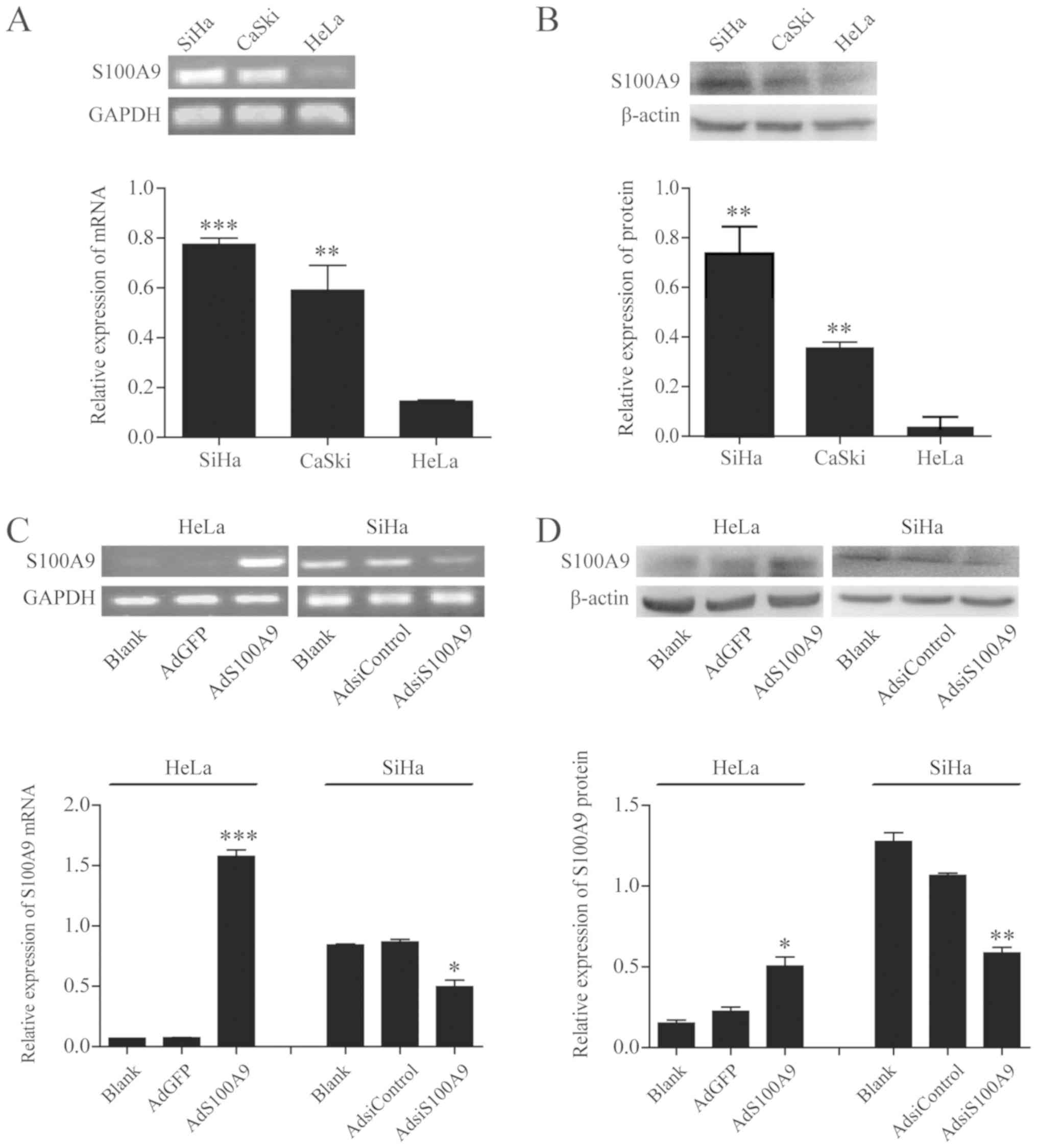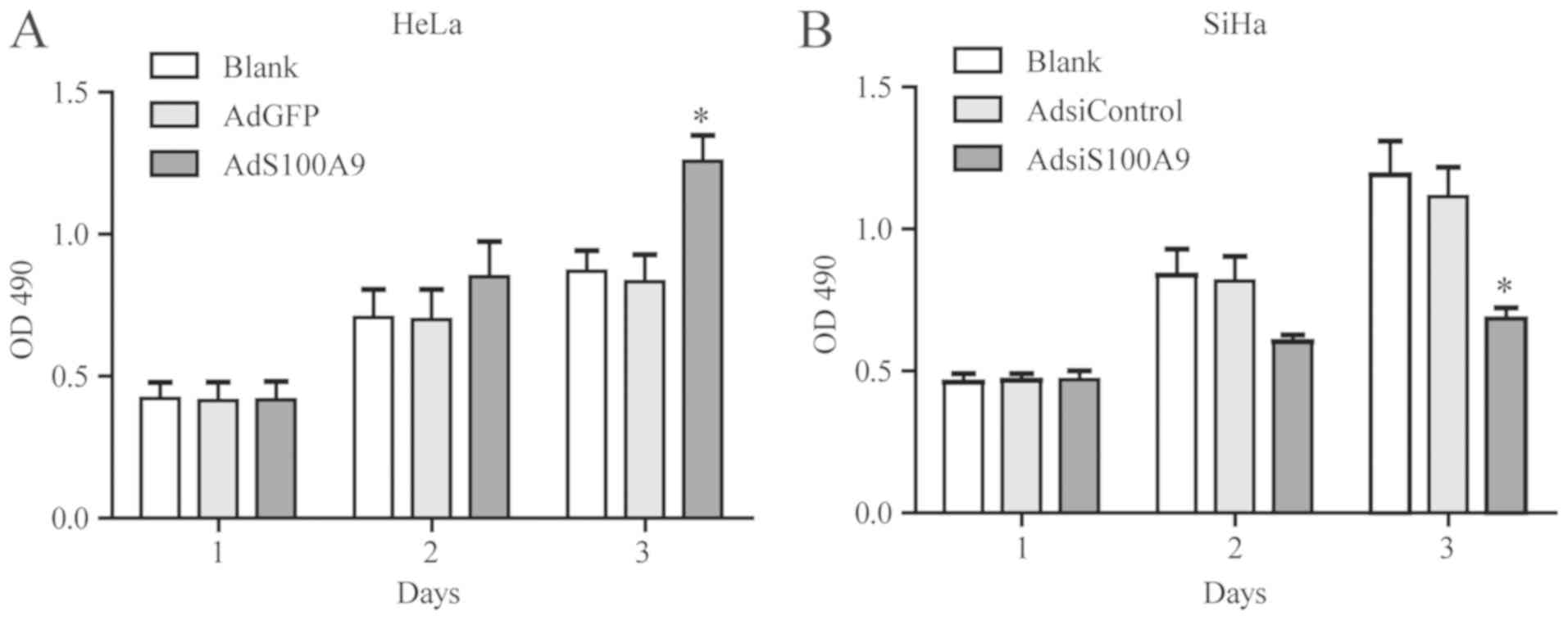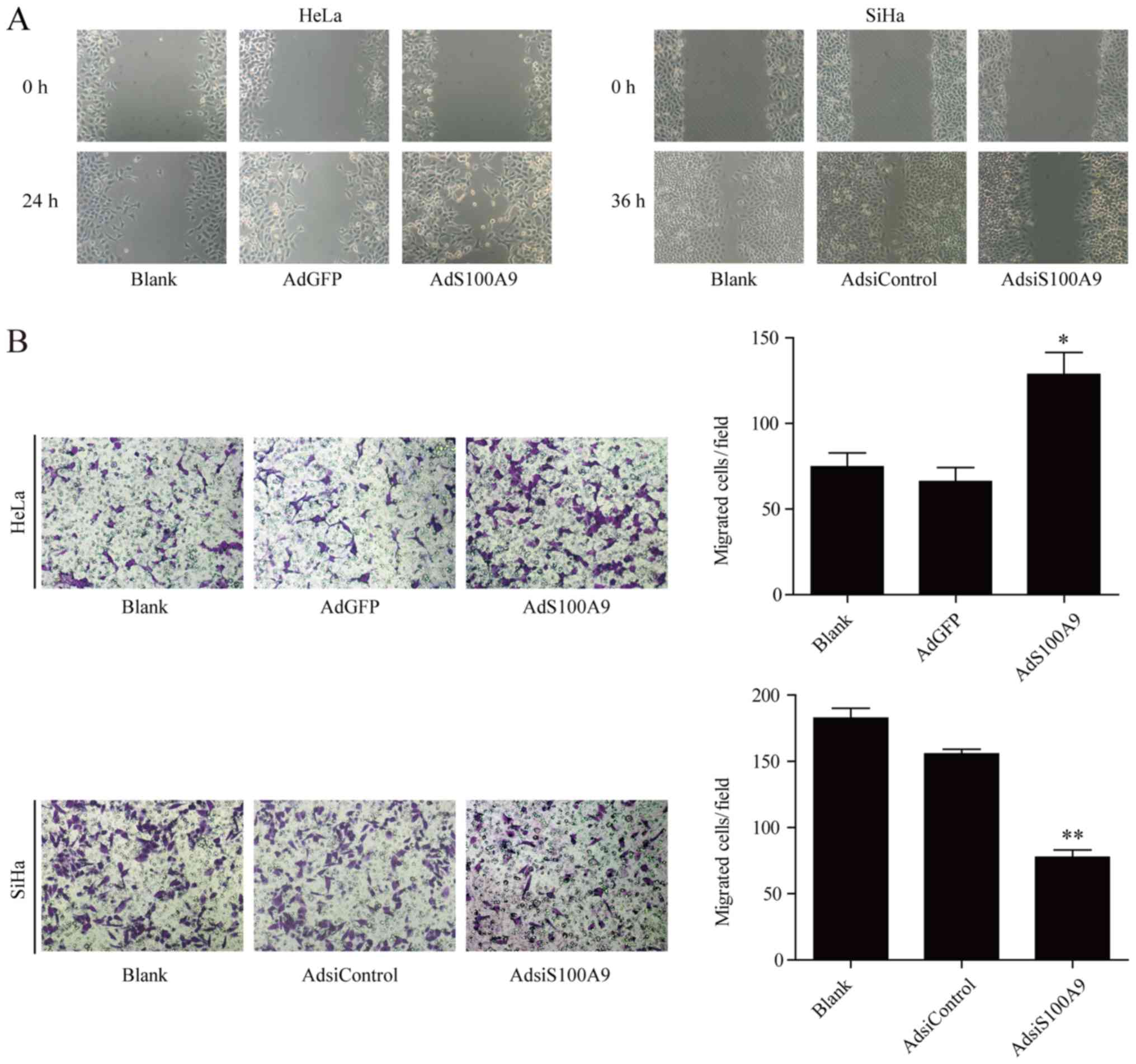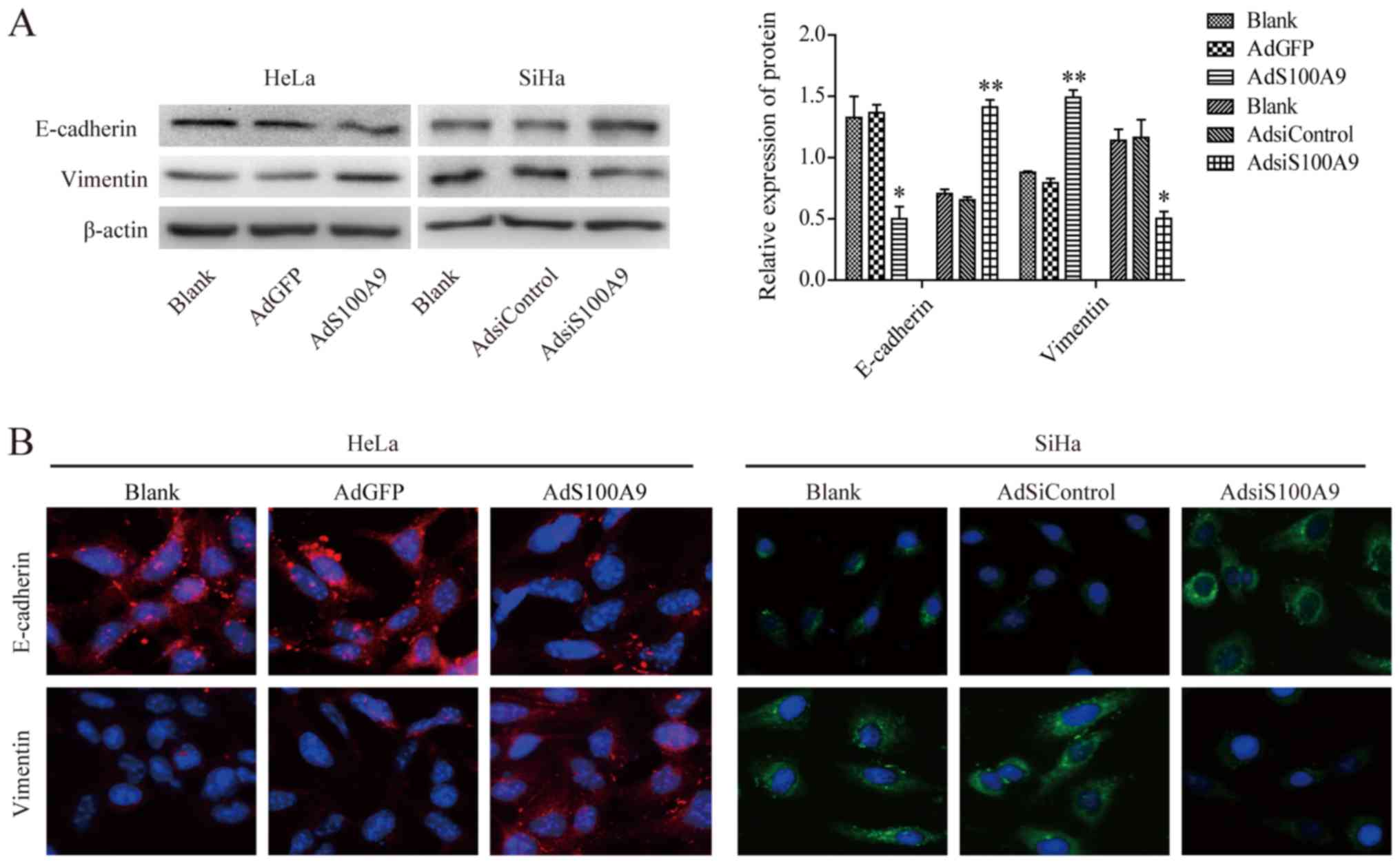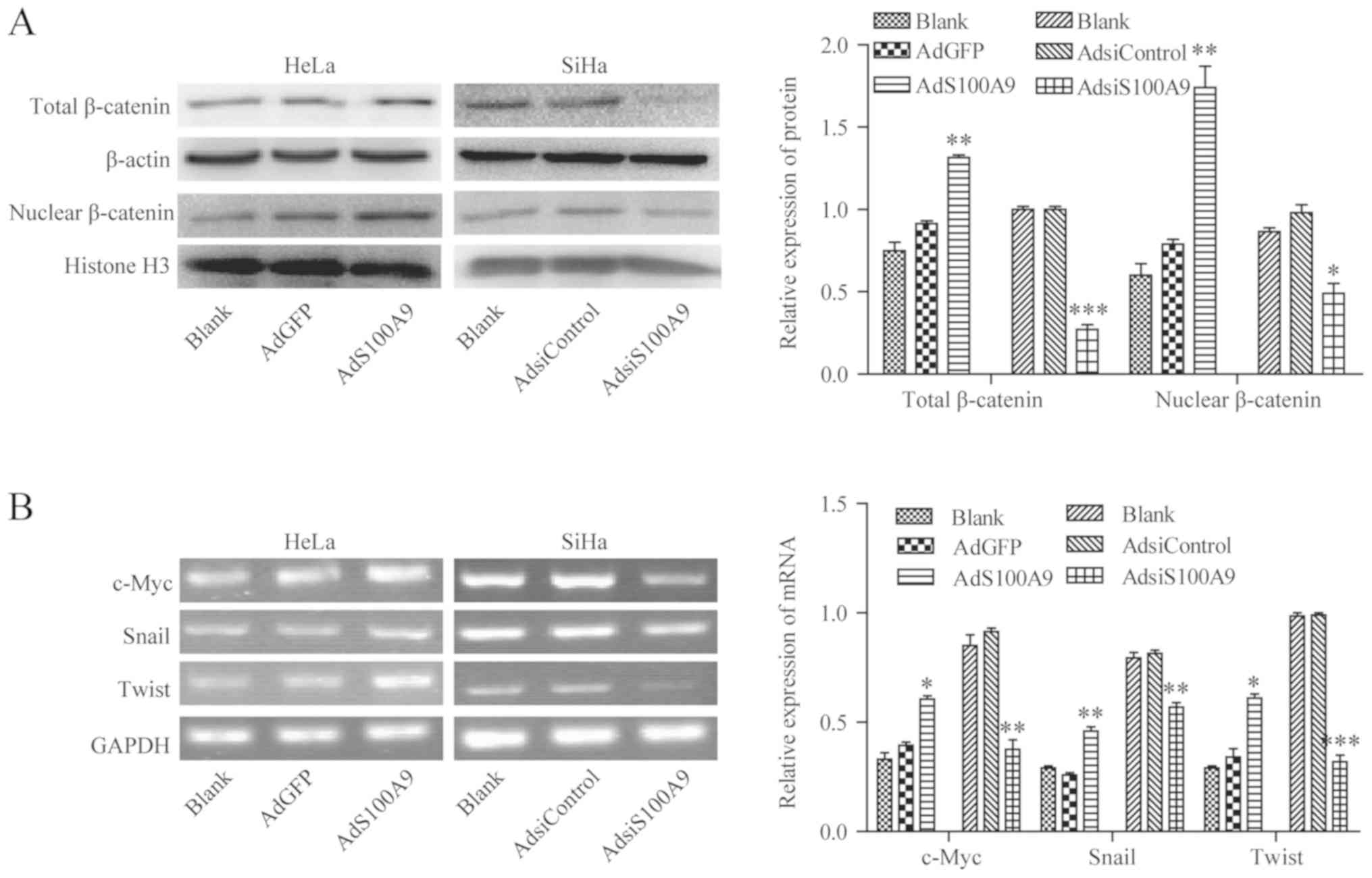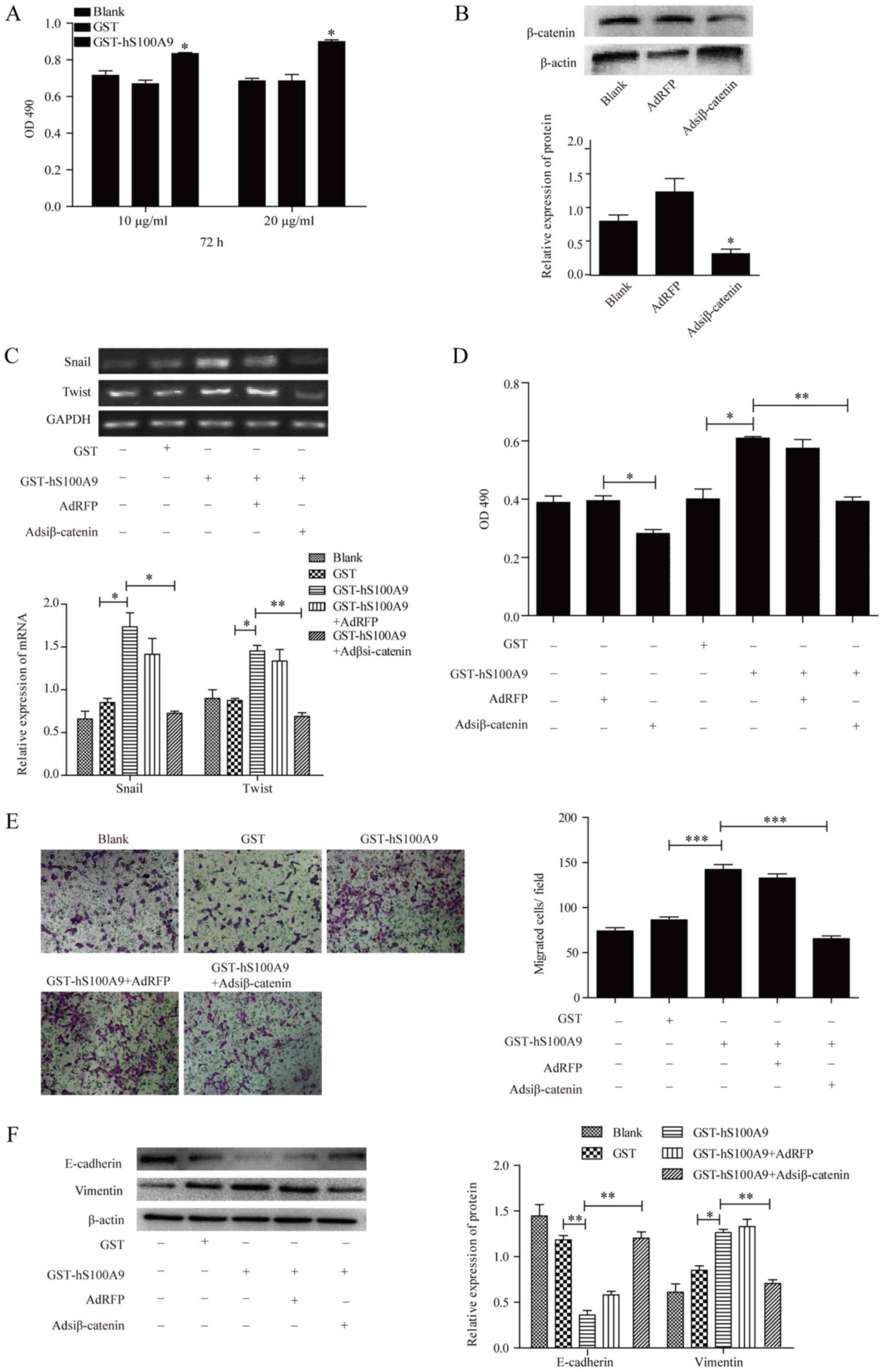|
1
|
Siegel RL, Miller KD and Jemal A: Cancer
statistics, 2018. CA Cancer J Clin. 68:7–30. 2018. View Article : Google Scholar : PubMed/NCBI
|
|
2
|
Zhang X, Wang Y, Cao Y, Zhang X and Zhao
H: Increased CCL19 expression is associated with progression in
cervical cancer. Oncotarget. 8:73817–73825. 2017.PubMed/NCBI
|
|
3
|
Wu R, Duan L, Ye L, Wang H, Yang X, Zhang
Y, Chen X, Zhang Y, Weng Y, Luo J, et al: S100A9 promotes the
proliferation and invasion of HepG2 hepatocellular carcinoma cells
via the activation of the MAPK signaling pathway. Int J Oncol.
42:1001–1010. 2013. View Article : Google Scholar : PubMed/NCBI
|
|
4
|
Wu R, Duan L, Cui F, Cao J, Xiang Y, Tang
Y and Zhou L: S100A9 promotes human hepatocellular carcinoma cell
growth and invasion through RAGE-mediated ERK1/2 and p38 MAPK
pathways. Exp Cell Res. 334:228–238. 2015. View Article : Google Scholar : PubMed/NCBI
|
|
5
|
Zhao Q, He Y, Wang XL, Zhang YX and Wu YM:
Differentially expressed proteins among normal cervix, cervical
intraepithelial neoplasia and cervical squamous cell carcinoma.
Clin Transl Oncol. 17:620–631. 2015. View Article : Google Scholar : PubMed/NCBI
|
|
6
|
Zhu X, Jin L, Zou S, Shen Q, Jiang W, Lin
W and Zhu X: Immunohistochemical expression of RAGE and its ligand
(S100A9) in cervical lesions. Cell Biochem Biophys. 66:843–850.
2013. View Article : Google Scholar : PubMed/NCBI
|
|
7
|
Qureshi R, Arora H and Rizvi MA: EMT in
cervical cancer: Its role in tumour progression and response to
therapy. Cancer Lett. 356B:B321–B331. 2015. View Article : Google Scholar
|
|
8
|
Yin C, Li H, Zhang B, Liu Y, Lu G, Lu S,
Sun L, Qi Y, Li X and Chen W: RAGE-binding S100A8/A9 promotes the
migration and invasion of human breast cancer cells through actin
polymerization and epithelial-mesenchymal transition. Breast Cancer
Res Treat. 142:297–309. 2013. View Article : Google Scholar : PubMed/NCBI
|
|
9
|
Yang M, Wang M, Li X, Xie Y, Xia X, Tian
J, Zhang K and Tang A: Wnt signaling in cervical cancer? J Cancer.
9:1277–1286. 2018. View Article : Google Scholar : PubMed/NCBI
|
|
10
|
Sun X and Liu Y: Activation of the
Wnt/β-catenin signaling pathway may contribute to cervical cancer
pathogenesis via upregulation of Twist. Oncol Lett. 14:4841–4844.
2017. View Article : Google Scholar : PubMed/NCBI
|
|
11
|
Shin S, Im HJ, Kwon YJ, Ye DJ, Baek HS,
Kim D, Choi HK and Chun YJ: Human steroid sulfatase induces
Wnt/β-catenin signaling and epithelial-mesenchymal transition by
upregulating Twist1 and HIF-1α in human prostate and cervical
cancer cells. Oncotarget. 8:61604–61617. 2017. View Article : Google Scholar : PubMed/NCBI
|
|
12
|
Busch EL, McGraw KA and Sandler RS: The
potential for markers of epithelial-mesenchymal transition to
improve colorectal cancer outcomes: A systematic review. Cancer
Epidemiol Biomarkers Prev. 23:1164–1175. 2014. View Article : Google Scholar : PubMed/NCBI
|
|
13
|
Duan L, Wu R, Ye L, Wang H, Yang X, Zhang
Y, Chen X, Zuo G, Zhang Y, Weng Y, et al: S100A8 and S100A9 are
associated with colorectal carcinoma progression and contribute to
colorectal carcinoma cell survival and migration via Wnt/β-catenin
pathway. PLoS One. 8:e620922013. View Article : Google Scholar
|
|
14
|
Li X, Zhou Q, Tao L and Yu C:
MicroRNA-106a promotes cell migration and invasion by targeting
tissue inhibitor of matrix metalloproteinase 2 in cervical cancer.
Oncol Rep. 38:1774–1782. 2017. View Article : Google Scholar : PubMed/NCBI
|
|
15
|
Ye H, Zhang Y, Geng L and Li Z: Cdc42
expression in cervical cancer and its effects on cervical tumor
invasion and migration. Int J Oncol. 46:757–763. 2015. View Article : Google Scholar
|
|
16
|
Wang C, Gu W, Zhang Y, Ji Y, Wen Y and Xu
X: Nicotine promotes cervical carcinoma cell line HeLa migration
and invasion by activating PI3k/Akt/NF-κB pathway in vitro. Exp
Toxicol Pathol. 69:402–407. 2017. View Article : Google Scholar : PubMed/NCBI
|
|
17
|
Xia C, Braunstein Z, Toomey AC, Zhong J
and Rao X: S100 proteins as animportant regulator of macrophage
inflammation. Front Immunol. 8:19082018. View Article : Google Scholar
|
|
18
|
Chen KT, Kim PD, Jones KA, Devarajan K,
Patel BB, Hoffman JP, Ehya H, Huang M, Watson JC, Tokar JL, et al:
Potential prognostic biomarkers of pancreatic cancer. Pancreas.
43:22–27. 2014. View Article : Google Scholar
|
|
19
|
Shibata F, Ito A, Ohkuma Y and Mitsui K:
Mitogenic activity of S100A9 (MRP-14). Biol Pharm Bull.
28:2312–2314. 2005. View Article : Google Scholar : PubMed/NCBI
|
|
20
|
Ghavami S, Rashedi I, Dattilo BM, Eshraghi
M, Chazin WJ, Hashemi M, Wesselborg S, Kerkhoff C and Los M:
S100A8/A9 at low concentration promotes tumor cell growth via RAGE
ligation and MAP kinase-dependent pathway. J Leukoc Biol.
83:1484–1492. 2008. View Article : Google Scholar : PubMed/NCBI
|
|
21
|
Hermani A, De Servi B, Medunjanin S,
Tessier PA and Mayer D: S100A8 and S100A9 activate MAP kinase and
NF-kappaB signaling pathways and trigger translocation of RAGE in
human prostate cancer cells. Exp Cell Res. 312:184–197. 2006.
View Article : Google Scholar
|
|
22
|
Jolly MK, Ware KE, Gilja S, Somarelli JA
and Levine H: EMT and MET: Necessary or permissive for metastasis?
Mol Oncol. 11:755–769. 2017. View Article : Google Scholar : PubMed/NCBI
|
|
23
|
Klymkowsky MW and Savagner P:
Epithelial-mesenchymal transition: A cancer researcher's conceptual
friend and foe. Am J Pathol. 174:1588–1593. 2009. View Article : Google Scholar : PubMed/NCBI
|
|
24
|
Li A, Gu Y, Li X, Sun H, Zha H, Xie J,
Zhao J, Huang M, Chen L, Peng Q, et al: S100A6 promotes the
proliferation and migration of cervical cancer cells via the
PI3K/Akt signaling pathway. Oncol Lett. 15:5685–5693.
2018.PubMed/NCBI
|
|
25
|
Wang X, Yang J, Qian J, Liu Z, Chen H and
Cui Z: S100A14, a mediator of epithelial-mesenchymal transition,
regulates proliferation, migration and invasion of human cervical
cancer cells. Am J Cancer Res. 5:1484–1495. 2015.PubMed/NCBI
|
|
26
|
Cain JM, Ngan H and Garland S; FIGO
Working Group on Combating Cervical Cancer: Control of cervical
cancer: Women's options and rights. Int J Gynaecol Obstet.
106:141–143. 2009. View Article : Google Scholar : PubMed/NCBI
|
|
27
|
Lustig B and Behrens J: The Wnt signaling
pathway and its role in tumor development. J Cancer Res Clin Oncol.
129:199–221. 2003.PubMed/NCBI
|
|
28
|
Kahn M: Can we safely target the WNT
pathway? Nat Rev Drug Discov. 13:513–532. 2014. View Article : Google Scholar : PubMed/NCBI
|















